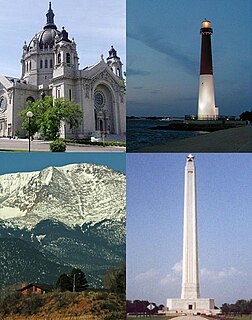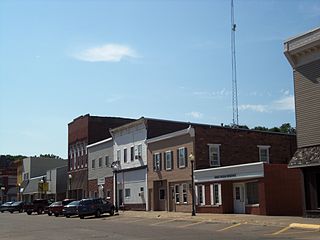The National Register of Historic Places (NRHP) is the United States federal government's official list of districts, sites, buildings, structures and objects deemed worthy of preservation for their historical significance. A property listed in the National Register, or located within a National Register Historic District, may qualify for tax incentives derived from the total value of expenses incurred in preserving the property.

Meramec State Park is a public recreation area located near Sullivan, Missouri, about 60 miles from St. Louis, along the Meramec River. The park has diverse ecosystems such as hardwood forests and glades. There are over 40 caves located throughout the park, the geology of which is a mixture of limestone and dolomite. The most famous is Fisher Cave, located near the campgrounds. The park borders the Meramec Conservation Area.

Washington State Park is a public recreation area covering 2,147 acres (869 ha) in the central eastern part of the state of Missouri located on Highway 21 about 14 miles (23 km) northeast of Potosi on the eastern edge of the Ozarks. The state park is noted for its Native American rock carvings and for its finely crafted stonework from the 1930s.

The Highland Historic District is a U.S. historic district in Middletown, Connecticut. Centered at the junction of Atkins Street and Country Club Road, the district encompasses a collection of well-preserved 18th and 19th-century architecture, including some of Middletown's oldest surviving buildings. The district was listed on the National Register of Historic Places in 1982.

In the law regulating historic districts in the United States, a contributing property or contributing resource is any building, object, or structure which adds to the historical integrity or architectural qualities that make the historic district significant. Government agencies, at the state, national, and local level in the United States, have differing definitions of what constitutes a contributing property but there are common characteristics. Local laws often regulate the changes that can be made to contributing structures within designated historic districts. The first local ordinances dealing with the alteration of buildings within historic districts was passed in Charleston, South Carolina in 1931.

The U.S. National Register of Historic Places (NRHP) classifies its listings by various types of properties. Listed properties generally fall into one of five categories, though there are special considerations for other types of properties which do not fit into these five broad categories or fit into more specialized subcategories. The five general categories for NRHP properties are: building, district, object, site, and structure.

The Crescent Warehouse Historic District is a 10.5-acre (4.2 ha) historic district in Downtown Davenport, Iowa, United States. The district is a collection of multi-story brick structures that formerly housed warehouses and factories. Most of the buildings have been converted into loft apartments. The district was listed on the National Register of Historic Places in 2003.

The Shelden Avenue Historic District is a commercial historic district located along Shelden, Lake, & Montezuma Avenues in Houghton, Michigan. The district contains 43 contributing buildings in an area of 22 acres. It was listed on the National Register of Historic Places in 1987.

Circa 21 Dinner Playhouse, formerly known as The fort Armstrong theater, is an historic building located in downtown Rock Island, Illinois, United States. It opened in 1920 and it was individually listed on the National Register of Historic Places in 1980. In 2020 it was included as a contributing property in the Downtown Rock Island Historic District.It was commonly referred to as the Fort Theater. The theater was named for Fort Armstrong, a fortification that sat in the middle of the Mississippi River near the present location of the Rock Island Arsenal. Its Waitstaff, The Bootleggers, are 1 of just 2 performing Waitstaffs in the USA

Green Park Historic District is a national historic district located at Blowing Rock, Caldwell County and Watauga County, North Carolina. The district includes 46 contributing buildings, 3 contributing sites, and 2 contributing structures associated with a residential summer resort in the town of Blowing Rock. It includes buildings largely built in the 1920s, in a variety of popular architectural styles including Bungalow / American Craftsman, Colonial Revival and Queen Anne. Notable contributing resources include the McDowell Cottage, Mt. Bethel Reformed Church, Blowing Rock Reception Center/Gift Shop, Robert A. Dunn Cottage, Gideon's Ridge, the James Ross Cannon House, the David Ovens Cottage, Blowing Rock, and the Blowing Rock Country Club Golf Course. Located in the district and separately listed is the Green Park Inn (1891).

The West Liberty Commercial Historic District in West Liberty, Iowa, United States, is a historic district that was listed on the National Register of Historic Places in 2002. At that time, it included 41 contributing buildings, six other contributing structures, and eight non-contributing buildings.

Cabins Historic District is a national historic district located near Novinger, Adair County, Missouri. The district encompasses nine contributing buildings, three contributing sites, four contributing structures, and one contributing object in a relatively isolated area near Novinger. It developed between about 1829 and 1865 and was one of the earliest settlements in the interior of northeast Missouri. It includes five antebellum structures surrounded by forests and farm land. They are the John B. Cain House, the Asa King Collett House, the Ira R. Collett House and its poultry house and summer kitchen. Other notable contributing resources include the Conner Tannery site, the Collett Spring, the site of Fort Clark, the site of Camp Collett, the Collett Cemetery, and Native American burial mounds.

Moreau Park Historic District is a national historic district located near Jefferson City, Cole County, Missouri. It encompasses seven contributing buildings, one contributing site, and five contributing structures associated with a former resort along the Moreau River near Jefferson City. The district developed between about 1914 and 1950, and includes some historic landscaping features, the native stone Dallmeyer House, Moreau Lodge (1914), one remaining guest cabin, two stone outbuildings, a privy, barn, and concession stand.

The First Battle of Newtonia Historic District, near Newtonia, Missouri, is a National Register of Historic Places (NRHP) site that preserves the location of the First Battle of Newtonia, an 1862 battle during the American Civil War. The battle saw Confederate troops under Colonels Douglas H. Cooper and Joseph O. Shelby defeat a Union force commanded by Brigadier General Frederick Salomon. The historic district contains some Civil War-period structures, as well as the Mathew H. Ritchey House, which is listed separately on the NRHP.

The Osage Farms Resettlement Properties in Pettis County, Missouri is a National Register of Historic Places multiple property submission located at Pettis County, Missouri. The submission includes 10 national historic districts and 2 individual properties listed on the National Register of Historic Places. The properties included were built by the Resettlement Administration / Farm Security Administration in 1937 as model farms and known as Osage Farms. Model farmsteads typically included a 1 1/2-story frame dwelling, barn, poultry house and privy.

Samuel T. and Mary B. Parnell House, also known as Mt. Branson Lodge, is a historic home located near Branson, Taney County, Missouri. It was built about 1912, and is a two-story, American Craftsman style dwelling constructed of irregular rubble courses of native stone. The front facade features a partial-width, two-story porch supported by massive, battered stone piers. Also located on the property is a contributing one-story, rock and wood frame garage.

Branson City Park Historic District was a national historic district located at Branson, Taney County, Missouri. The district encompassed one contributing site and two contributing structures built between 1934 and 1943 as part of a Works Progress Administration project. They were the Mang Field Bleachers, Mang baseball field and the Stone Bleachers. The bleacher structures were good examples of the use of rustic native stone by means of the slab rock technique. The park has been demolished and replaced with The Branson Landing.

Prairie View Stock Farm, also known as the Bluestem Ranch, is a historic farm and national historic district in western Missouri located near Rich Hill; it covers territory in both Bates and Vernon counties. The district encompasses four contributing buildings, three contributing sites, and two contributing structures in a Rural Historic Landscape District. The contributing sites include a hay meadow, a tall-fescue prairie, and a 160-acre plot of native, tall-grass prairie. It is a state-designated Prairie View Natural Area.

The Oxford Commercial Historic District is a nationally recognized historic district located in Oxford, Iowa, United States. It was listed on the National Register of Historic Places in 1997. At the time of its nomination it consisted of 20 resources, which included 16 contributing buildings and four non-contributing buildings. This district reflects a typical central business district found in a Midwest town. It represents a transitional period from a frontier town to a settled community, and from the horse as the primary means of transportation to the automobile and mechanized farming. Most of the buildings in Oxford's business district were constructed between 1883 and 1917. Some replaced the wood frame structures from the town's frontier days, while others replaced those destroyed by a major fire that consumed the north side of the district in 1890. They are one to two stories in height, and their exteriors are composed of common brick. While simple in composition, many feature ornate decorative cornices. The Italianate and Romanesque Revival styles dominate.

The Wilton Commercial Historic District is a nationally recognized historic district located in Wilton, Iowa, United States. It was listed on the National Register of Historic Places in 2016. At the time of its nomination it consisted of 47 resources, which included 32 contributing buildings, one contributing structure and 14 non-contributing buildings. Wilton got its start when the Mississippi and Missouri Railroad, later the Chicago, Rock Island and Pacific, was surveyed through this area in 1853. It was named for Wilton, Maine, the hometown of one of the founders.


















